Co-accompanier Rajesh and I are sitting in the office of Nora Nasser, principal of Cordoba school in Hebron’s H2 area. The school is surrounded by illegal settlements and the settlers living here are reputed for being exceptionally aggressive and  violent. Every day the children of Cordoba school have to pass a military installation with steel turnstiles at the entrance of Shuhada street, Checkpoint 56. The school route runs approximately 250 meters along Shuhada street to another checkpoint without steel or concrete installations, just with a number of soldiers monitoring the traffic. At this checkpoint (named CP55) the children turn right to climb approximately 50 steps up a steep stone stair, where they will be able to turn left into the relatively safe final strech before reaching the school gates 100 meters ahead.
violent. Every day the children of Cordoba school have to pass a military installation with steel turnstiles at the entrance of Shuhada street, Checkpoint 56. The school route runs approximately 250 meters along Shuhada street to another checkpoint without steel or concrete installations, just with a number of soldiers monitoring the traffic. At this checkpoint (named CP55) the children turn right to climb approximately 50 steps up a steep stone stair, where they will be able to turn left into the relatively safe final strech before reaching the school gates 100 meters ahead. 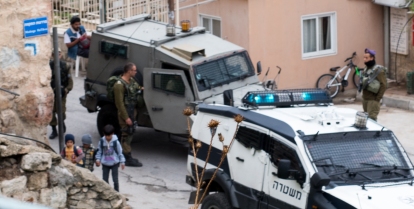 Cordoba school has some 100 pupils, grade 1-9. Grade 1-7 is mixed boys and girls and grade 7-9 is for girls. In addition some 15-20 pre-school children use this road to get to kindergarten. This school route has just now been declared a closed military zone. The Cordoba children have lived with the constant underlying anxiety about going to school for many years. Now it seems worse than ever. It was October 2015.
Cordoba school has some 100 pupils, grade 1-9. Grade 1-7 is mixed boys and girls and grade 7-9 is for girls. In addition some 15-20 pre-school children use this road to get to kindergarten. This school route has just now been declared a closed military zone. The Cordoba children have lived with the constant underlying anxiety about going to school for many years. Now it seems worse than ever. It was October 2015.
On 21 September 18 year old Hadeel Hashlamoun was shot dead with ten bullets inside Checkpoint 56. Amnesty International has claimed this to be an extrajudicial killing, meaning that she was standing behind a steel bar and represented no immediate threat to the soldiers’ life, even if there had been truth to the Israeli claim that she had a knife. Extensive photo footage from the scene shows no sign of a knife. From this date Shuhada street area has seen the killing of three more young Palestinians, some after stabbing attempts and others obvious executions done by soldiers or armed settlers. Fadel al-Qawasmi was shot and killed by an Israeli settler claiming that Fadel had attempted to stab him. A video shows soldiers planting a knife near his dead body. There is also photo coverage of a laughing settler taking a selfie above the bleeding body. Photo and video documentation of the killings on social 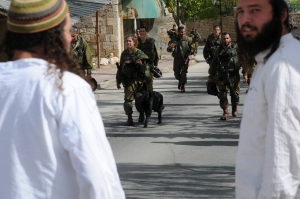 media has probably contributed heavily to the military decision to declare the school route to Cordoba a closed military zone, prohibiting both Palestinians without residence permit in the area and international volunteers from entering. The tension is at present so high that the teachers are afraid of tomorrow, thinking on how to get to work.
media has probably contributed heavily to the military decision to declare the school route to Cordoba a closed military zone, prohibiting both Palestinians without residence permit in the area and international volunteers from entering. The tension is at present so high that the teachers are afraid of tomorrow, thinking on how to get to work.
Nora Nasser serves us strong Arabic coffee. With some assistance from English teacher Lamiah she begins to tell about the current situation:
“Both teachers and pupils are afraid. Some of the children have difficulty sleeping and stay at home.” A week ago only 79 of the +100 pupils attended school. Today the number had risen to 97. “We see the stress of the children through lower marks. They have no self-esteem any more.” We ask about what specifically worries the children and are told that they are afraid of being run down by settlers driving on Shuhada street. Lamiah adds that the soldiers at the checkpoints now have their guns raised, pointing the barrels at the children. This is new. Guns are usually pointing donwards. Having a huge gun directed at you has a 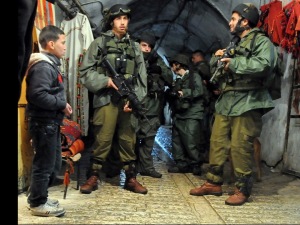 strong effect on most people. When repeated every day when you are going to school, psychosocial reactions are bound to happen. Both of them tell us that the children are now much more sensitive to sharp and sudden sounds. Social councelor Reem Natjheh tells us later that some of the children also wet themselves. “The three last weeks“, Nora tells us, “we have left school earlier than usual. We receive messages and rumours about clashes and take no chances. We want to take the children out through the checkpoint before it gets closed“. Lamiah sighs and says she has missed quite a lot of English classes lately. The day before soldiers had stopped both teachers and children and told them to take another way to the school. Principal Nora Nasser looked the commanding officer in the face and exclaimed: There is no other way! They were let through. She now looks us straight in the face and says firmly: “Our message is that we will not leave the school. We have Educational Sumud!” Both Rajesh and I, being well aware that the concept of sumud goes to the core of Palestinian identity, meaning resilience and steadfastness, can feel the enormous strength coming from Nora and Lamiah.
strong effect on most people. When repeated every day when you are going to school, psychosocial reactions are bound to happen. Both of them tell us that the children are now much more sensitive to sharp and sudden sounds. Social councelor Reem Natjheh tells us later that some of the children also wet themselves. “The three last weeks“, Nora tells us, “we have left school earlier than usual. We receive messages and rumours about clashes and take no chances. We want to take the children out through the checkpoint before it gets closed“. Lamiah sighs and says she has missed quite a lot of English classes lately. The day before soldiers had stopped both teachers and children and told them to take another way to the school. Principal Nora Nasser looked the commanding officer in the face and exclaimed: There is no other way! They were let through. She now looks us straight in the face and says firmly: “Our message is that we will not leave the school. We have Educational Sumud!” Both Rajesh and I, being well aware that the concept of sumud goes to the core of Palestinian identity, meaning resilience and steadfastness, can feel the enormous strength coming from Nora and Lamiah.
chance later in the day we come across a blogpost written two years ago by a former accompanier in Hebron, Øystein Nedrebø, showing photos of the courageous and steadfast principal protecting and defending her pupils against the harsh military realities along the school route. It is the same strength we witnessed in her office.
Social worker Reem Natjheh has only been at Cordoba for a couple of weeks, as a substitute. Fear is the dominant problem, she says. The children come to her and ask for counselling. She can talk with them about their feelings of fear, she encourages them to use drawing and toys to express their fear, and she lectures in whole classes about relaxing techniques and how to be prepared for the situations they fear most. I’m reminded of Amira Hass’ harsh criticism of the Palestinian educational authorities two years ago in her Haaretz article The Inner Syntax of Palestinian Stone-hrowing. In the article she flogs the PA for not including ‘living under occupation’ on the curriculum.
“The other problem“, Reem says, “is violence against each other, boys and girls. Especially 6th grade boys are very active and express themselves in cruel and violent ways, like in prison. These boys dream about being freedom fighters”. Half an hour later we see her intervene between two boys, intensely talking to one of them, whose face is distorted with anger. Writing this blogpost I find myself wondering, once again, about my own reluctance to enter into the psychological domain of violence. Why do I flinch when Reem mentions the young boys’ dreams of being freedom fighters? Why is it that when I share links to the 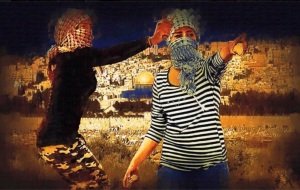
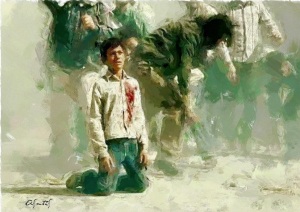
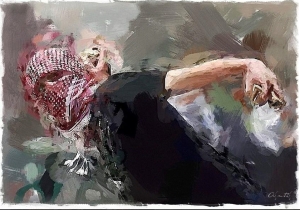 website The Art of Occupied Palestine on my Facebook timeline, I always select the beautiful images, those of longing and close family ties and skip the violent resistance images of freedom fighters? I have told myself that my Facebook friends, probably feeling nauseated by my steady flow of links to articles and ugly news from Palestine and Israel, deserve to see something beautiful coming out of this hellhole. But it is not only that. It is also about my own confusion. Amira Hass says in her article: Throwing stones is the birthright and duty of anyone subject to foreign rule. Throwing stones is an action as well as a metaphor of resistance. Wow! Isn’t stone-throwing what causes the harsh military response, and isn’t stone-throwing what sends young boys (and girls) to administrative detention and imprisonment for extended periods, resulting in deep traumatisation and destroyed families? Yes. And yet, what are the options? After a prolonged period of relative calm after the end of the extremely violent 2nd Intifada, there is only one picture to be seen, one lesson to be learned:
website The Art of Occupied Palestine on my Facebook timeline, I always select the beautiful images, those of longing and close family ties and skip the violent resistance images of freedom fighters? I have told myself that my Facebook friends, probably feeling nauseated by my steady flow of links to articles and ugly news from Palestine and Israel, deserve to see something beautiful coming out of this hellhole. But it is not only that. It is also about my own confusion. Amira Hass says in her article: Throwing stones is the birthright and duty of anyone subject to foreign rule. Throwing stones is an action as well as a metaphor of resistance. Wow! Isn’t stone-throwing what causes the harsh military response, and isn’t stone-throwing what sends young boys (and girls) to administrative detention and imprisonment for extended periods, resulting in deep traumatisation and destroyed families? Yes. And yet, what are the options? After a prolonged period of relative calm after the end of the extremely violent 2nd Intifada, there is only one picture to be seen, one lesson to be learned:
- The continuous loss of land to a Knesset-supported influx of new settlements on Palestinian territory.
- The international community shying away from putting effective (= economic) pressure on the Israeli government to find a solution based on the 1967 borders.
- The donor countries (under the leadership of Norway) providing funding of the Palestinian National Authority contingent on a working security coordination between the PA and Israeli Security Forces.
- The rivalry between Hamas and Fatah impeding the emergence of a much needed Mandela-format political leader when Mahmoud Abbas soon retires.
- The next American president will go on funding the Israeli military and provide vetos to any critical resolutions in the UN.
Not at all unexpectedly, the black October we have seen throughout the West Bank is simply a result of the collective despair we meet on a daily basis as accompaniers. The young boys and girls who walk into military checkpoints and pull out their kitchen knives know they will die. They do it out of despair and hopelessness. They do it as a result of the international community’s inability to change the political situation.
A couple of days ago the Palestinian Hebron-based organisation YAS, Youth Against Settlements, had their house in Tel Rumeida raided and closed by the army. The leader of YAS, Issa Amro, told me during the funeral of the non-violent resistance icon of Hebron, Dr. Hashem Al-Azzeh, “We have to go to the streets. We have to go on resisting. They want us to live in a nice occupation. We cannot live in a nice occupation!’.
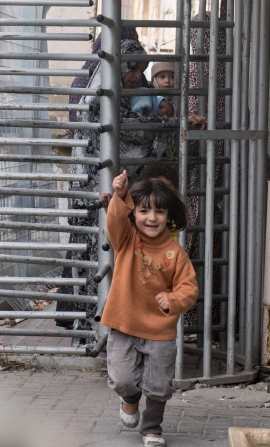 Looking through my photos to go with this blogpost I suddenly realise one of the main sources of my growing sadness and despair being here this time. The photo of five year old Malak (not her real name) triumphantly emerging through the turnstile of Checkpoint 56 at the entrance of Hebron’s Shuhada street usually triggers responses like ‘Oh, how cute!!’. This was also my initial reaction to the photo after taking it. Now I’m just choking with despair about the realities of Malak’s childhood. Access to education through a steel turnstile and a closed military zone is imposed on her by the Israeli government. The only democracy in the region, they claim. Not for Malak.
Looking through my photos to go with this blogpost I suddenly realise one of the main sources of my growing sadness and despair being here this time. The photo of five year old Malak (not her real name) triumphantly emerging through the turnstile of Checkpoint 56 at the entrance of Hebron’s Shuhada street usually triggers responses like ‘Oh, how cute!!’. This was also my initial reaction to the photo after taking it. Now I’m just choking with despair about the realities of Malak’s childhood. Access to education through a steel turnstile and a closed military zone is imposed on her by the Israeli government. The only democracy in the region, they claim. Not for Malak.

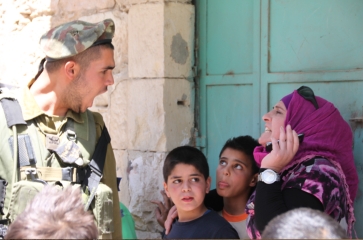
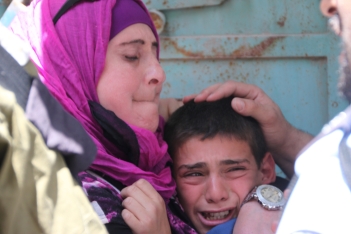
Takk for gode reportasjer, Bjørn Gunnar!
Trond
Den 09.11.2015 17:27, skrev blogsaltnes:
> bgsaltnes posted: “Co-accompanier Rajesh and I are sitting in the office of Nora Nasser, principal of Cordoba school in Hebron’s H2 area. The school is surrounded by illegal settlements and the settlers living here are reputed for being exceptionally aggressive and violent.” > >
LikeLike
Kor viktig det er med slike vitne som deg, Bjørn Gunnar!
Beste helsing
Gurid
LikeLike
Hi
Hope you are well! I am writing an article on children in Palestine and I was wondering if you’d be so kind as to give me permission to use your first image which shows children passing an Israeli checkpoint on their way to school.
Obviously I would be more than happy to credit you if you agree?
many thanks and look forward to your reply
LikeLike
You are welcome to use my photo/s. Regards, Bjørn Gunnar
LikeLike